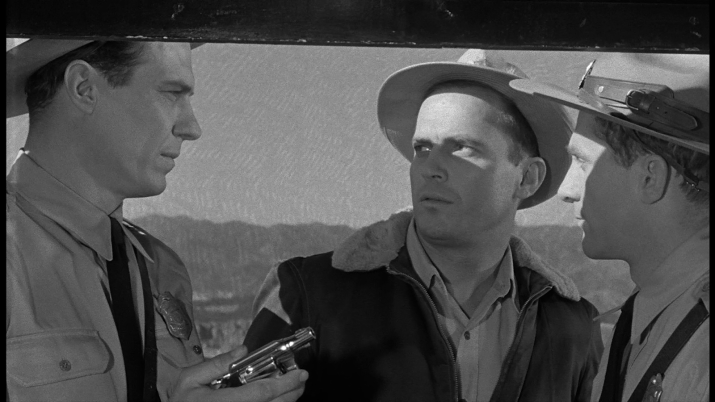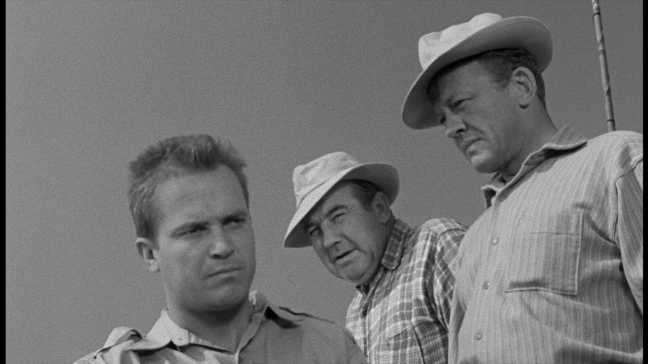If we look to specific movies in the evolution of gangster films and the on screen violence within, surely this prison drama from producer Aubrey Schenck and director Howard W. Koch has to be considered as a front runner from the mid fifties. Tame by today’s standards but clearly ahead of it’s time and with a couple scenes that haven’t entirely lost their cinematic effect, Ralph Meeker stars in the central role of “The Iceman.” He’s thought to be responsible for the disappearance of a small boy during a kidnapping scheme gone wrong.
In the opening segment we’ll find a small child gone missing from his scout camp in the mountain parks of Colorado. He’s located by Meeker, appearing to be a hiker in on the search. Meeker has a peculiar coldness about him and the scenes with the child have an unnerving feel to them. He’ll stow the boy away in an abandoned Ranger tower and make his way to the nearest call center where he will unveil that he’s holding the child for ransom. He’ll collect a 200K bounty from the distressed Willis Bouchey as the boys father and promptly commit one of the more graphic acts viewers were likely to see on movie screens during the decade.
Through happenstance, Meeker will be found out at a local roadblock and admits to the scheme of extorting money from Bouchey but never once seeing the child. He’s taken advantage of the missing boy reports to extract the cash and nothing more. Agent Reed Hadley won’t give up the case so easily and Meeker finds himself sent to prison on a lesser charge.
Time to introduce Meeker’s Iceman to his star studded cellmates who initially want nothing to do with the supposed child killer. Broderick Crawford is the head man, William Talman is a member of the gang, Lon Chaney Jr. in a partial take on Lennie has a bunk and appearing as the fourth member and the “muscle” of the gang is a mostly shirtless Charles Bronson. Meeker wants nothing to do with his new cellmates and intends to ride out his time causing no trouble and make his way back to the hidden 200K he has left buried in the mountain peaks of Colorado.
“I’m gonna kidnap a kidnapper.”
Crawford explains to his quartet of underlings as they are about to embark on an escape attempt. Meeker is forced along and realizes the reason why. They want his 200K. Looking a lot like Alcatraz, the gang will swim to their freedom where a boat awaits their arrival. It’s at this point that Meeker will see just how serious Crawford is when two members of the gang are murdered outright. One of which is bludgeoned to death and then burnt to simulate a fire, erasing his facial features. All Meeker has to do is change clothes with the victim so the police will assume he’s dead and not bother to stakeout the area thought to contain the hidden money.
Brod’s got it all figured out except the bulldog Reed, still actively working the case of the Iceman and trying to tie him in with the missing boy. He may have found the thread that ties the two together when questioning camp nurse Felicia Farr and checking into her background.
We all know that crime doesn’t pay in films of this era so we should expect what’s coming by the fadeout but it’s getting there that must have proved to be a newfound experience for ticket buyers of the day. Murder, kidnapping, death by gunshots, scalding, hammers, and falls. We’re not talking modern day horror films here that leave nothing to the imagination, but just the sheer suggestion of these violent acts and the carrying out of them are leagues ahead of what may have been filmed in the decade prior to this one. I’ve always looked to Raoul Walsh’s White Heat and The Big Combo with Cornel Wilde as the films prior to this one that are titles we can easily point to when looking at the rise of on screen violence in the gangster film genre.
Even at the close of the film, you might be surprised though I’m not giving away the final scene.
I guess we’ll have to classify this as a “B” film in the end but it has a cast worthy of an A budget production. The performers are all well suited to their roles and deliver the goods from Meeker on down to the up and coming Bronson. The pair would of course reunite when Bronson’s star was on the rise and Meeker was relegated to character roles in the 1967 classic, The Dirty Dozen. Off screen pals, Crawford and Chaney would work together in two films during the 55 season, this one and the star studded weeper, Not as a Stranger.
Meanwhile, Talman was closing in on his role in the long running Perry Mason show and the beautiful Miss Farr who was debuting here as Randy Farr would star in a number of films before marrying Jack Lemmon including her “official” debut as Felicia the following year in one of the best Glenn Ford oaters that also featured Bronson, Jubal.
Big House U.S.A. was put out by Kino on blu ray with another quartet of titles making for a solid Noir collection if you happen to be looking to add a five pack noir titles and a certain criminal element to your personal library. Among them are Storm Fear and Witness to Murder.
Finally for those who are aware of my penchant for collecting the film posters of Charles Bronson, this one sheet represents the oldest poster from my personal collection bearing his name and image. Having Lon Chaney Jr. on here is an added bonus. Here it is with another of my blatant self promoting photos.









Another early ‘surprisingly violent for the time’ film to add to the list might be ‘Brute Force’, the prison noir starring Burt Lancaster. And that sounds like a cool five-pack of noirs…I’ll give it a look. And I love that all your poster photos take place at the top of the stairs…like standing anywhere beyond that is against the rules!
Yes, that Burt film is a game changer as well. This one has a real fun cast but no Brute Force. If I move any farther from the Vault, I get worried I might be the victim of a heist. 🙂
Ha! A heist! Just be sure to film it and post it on your site!
I would class this film more of a programmer than a mere B Movie.
As you say the cast is exceptional and it’s an incredibly tough movie
for the era.
The biggest shock in the film is seeing the normally sweet Felicia play an
evil nurse-especially when Reed Hadley gets on her case.
in her previous film Mark Stevens’ very fine TIMETABLE she is also a
bad gal…I’m so glad that she cleaned up her act.
All this reminds me that I recently watched CHARLEY VARRICK (one of
the 70’s best IMHO) and enjoyed seeing Felicia and Walter in the sack
together.
Varrick a darn good movie too! Yes, Farr was so captivating in Jubal and 3:10 to Yuma that it’s against type in here as the wicked nurse.
Good plot and cast but excessive violence . Loved seeing Reed Hadley on the right side of the law for once.
It is a good one and the cast top flight. Hadley’s good here as the bulldog who won’t let go.
There is a scene in the excellent and generally unheralded HIGHWAY 301 that tops the Farr/Hadley scene.
In HIGHWAY 301 Edmon Ryan really puts the heat on Virginia Grey..their scenes are sensational.
I also love Felicia in THE LAST WAGON and REPRISAL! and HELL BENT FOR LEATHER which is my all
time fave Audie Murphy Western. BTW to correct my previous comment TIMETABLE was made after
BIG HOUSE USA.
Haven’t seen 301 but have it. Farr was a beauty. Last Wagon a very good film. Been years since I’ve seen Hell Bent. Have the poster in the vault here somewhere though.